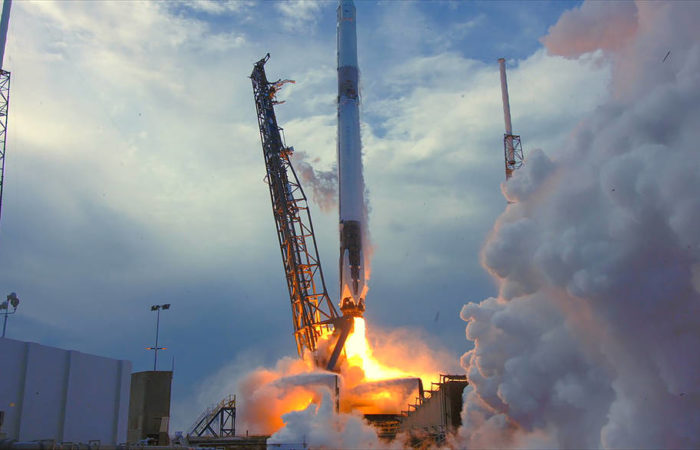Cape Canaveral, Florida – April 4, 2018 – NanoRacks, the leading provider for commercial access to low-Earth orbit, has brought yet another unique payload mission to the International Space Station. Carrying a professional protein crystal experiment, college-level biological research, and a debris capturing microsatellite (MicroSat), this mission continues to push the boundaries of commercial opportunities on the International Space Station.
The SpaceX CRS-14 Dragon was successfully installed on the Harmony module of the International Space Station at 9:00 EDT this morning.
NanoRacks third flagship MicroSat mission is the RemoveDebris satellite from The University of Surrey/Surrey Space Centre. The RemoveDebris satellite is planned to be deployed from the NanoRacks Kaber Deployer (Kaber). NanoRacks created the Kaber system to accommodate the increasing customer demand for commercial opportunities to deploy MicroSats from the Space Station. Kaber offers deployments for satellites up to 100 kilograms.
RemoveDebris is a low-cost mission funded jointly by the European Commission (EU) and 10 partners. Surrey Space Centre (University of Surrey) leads the consortium. The consortium consists of: Airbus, Ariane Group (France); Surrey Satellite Technology Ltd (United Kingdom); Innovative Solutions In Space (Netherlands); CSEM (Switzerland); Inria (France); and Stellenbosch University (South Africa).
Once deployed, RemoveDebris will deploy two CubeSats as artificial debris targets to demonstrate some of the technologies being discussed for orbital debris removal. These technologies include: net capture, harpoon capture, vision-based navigation, and “dragsail de-orbitation.”
The United Kingdom Science Minister, Sam Gyimah, said in a recent University of Surrey press release: “Space debris is a growing concern so it’s great to see a British university and our innovative space sector leading the way in the search for solutions. It is also a fantastic example of the unique expertise found in the UK’s growing space sector and the value that it adds to international projects.”
Additionally on this mission is the Real Time Protein Crystal Growth (Real Time PCG) experiment which seeks to demonstrate the feasibility of conducting protein crystal growth experiment in live time on the Space Station. The astronaut crew is scheduled to add solution to the hardware, observe the crystals that form, and then adjust as necessary for follow on experiments. This approach gives scientists the ability to optimize crystal growth in microgravity instead of losing time on sample return to the Earth and re-launch.
Real Time PCG, a project led by Barrios Technology, features NanoRacks as the implementer, and it will utilize the NanoRacks Microscope on orbit.
Lastly, the Calumet College of St. Joseph will be running an experiment studying the proteins behind Alzheimer’s disease. The experiment will examine fibril formation and beta amyloid peptides using a fluorescence spectrometer. The beta amyloid peptides are behind the breakdown of brain cells, effecting how quickly Alzheimer’s disease advances. This experiment is the second of two projects selected through the Center of Advancement of Science in Space (CASIS) National Design Challenge.
“These are two significant research experiments,” says NanoRacks Senior Internal Payloads Manager, Mary Murphy. “To run these projects, we’re utilizing our Frame 2B, as well as our microscope. These are pieces of hardware that mimic how scientists conduct research on the ground, making it as simple as one can make it to conduct similar research in microgravity. We look forward to seeing the results of both the protein crystals and the Alzheimer’s proteins.”
For continued updates, be sure to follow @NanoRacks on Twitter.
About NanoRacks
NanoRacks is enabling space research and in-space services to customers world-wide from multiple platforms and launch vehicles. The company offers low-cost, high-quality solutions to the most pressing needs for satellite deployment, basic and educational research and both at home and in 30 nations world-wide for those new to the industry and aerospace veterans. Since 2009, Texas-based NanoRacks has truly created new markets, and ushered in a new era of in space-services.
In July 2015, NanoRacks signed a teaming agreement with Blue Origin to offer integration services on their New Shepard space vehicle. NanoRacks, along with partners at ULA and Space Systems Loral was also selected by NASA to participate in the NextSTEPs Phase II program to develop commercial habitation systems in low-Earth orbit and beyond.
NanoRacks signed an additional Space Act Agreement with NASA in 2016 to install the first-ever private Airlock Module on the International Space Station. In February 2017, NanoRacks announced two partnerships with both Boeing and Thales Alenia Space to produce features of the Airlock.
As of April 2018, over 600 payloads have been launched to the International Space Station via NanoRacks services, and our customer base includes the European Space Agency (ESA) the German Space Agency (DLR,) the American space agency (NASA,) US Government Agencies, Spire, Millennium Space Systems, Space Florida, NCESSE, Virgin Galactic, pharmaceutical drug companies, and organizations in Vietnam, UK, Romania, Israel and beyond.

